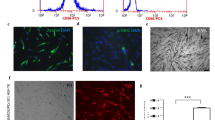Abstract
Clinical outcome after myocardial infarction depends on the extent of irreversibly damaged myocardium. Implantation of bone marrow-/circulating blood-derived progenitor cells has been shown to improve contractile cardiac function after myocardial infarction in both experimental and initial clinical studies. In the present study, first observations of the effect of local intracoronary progenitor cell infusion on the regeneration of infarcted cardiac tissue after acute myocardial infarction was evaluated by means of 18F-fluorodeoxyglucose positron emission tomography (PET) and 201Tl single-photon emission computed tomography (SPECT). Twenty-six patients underwent intracoronary infusion of bone marrow-derived (BMCs) (15 patients) or circulating blood-derived endothelial progenitor cells (EPCs) (11 patients) 4±2 days after acute myocardial infarction. Based on a left ventricular segmentation model (17 segments), mean signal intensities as a parameter of viability and perfusion in the infarct zone and non-infarct areas were calculated quantitatively by PET and SPECT at baseline and at 4 months of follow-up. Transplantation of progenitor cells was associated with a significant increase in the mean signal intensity (MSI) in the infarct zone from 54.5% (25th and 75th percentiles: 47.7%, 60.0%) to 58.0% (52.7%, 66.7%) on PET (P=0.013) and from 58.0% (49.5%, 63.0%) to 61.5% (52.5%, 70.2%) on SPECT (P=0.005). Global left ventricular ejection fraction (LVEF) increased from 53.5% (42.6%, 60.0%) to 58.0% (53.0%, 65.8%) (P<0.001). In the five patients without an increase in MSI on PET, LVEF changed from 60.0% (50.0%, 64.0%) to 72.0% (64.0%, 75.5%) at follow-up. PET and SPECT did not show any significant changes in MSI in the non-infarct areas [from 73% (68.5%, 76.2%) to 73% (69.7%, 78.0%) for PET and from 72.0% (66.5%, 77.6%) to 73.0% (67.5%, 78.2%) for SPECT]. There were no significant differences in myocardial viability and perfusion between BMC and EPC infusion. These preliminary results show that coronary stenting and transplantation of progenitor cells result in a significant increase in myocardial viability and perfusion. Therapeutic effects can be reliably measured by PET and SPECT.





Similar content being viewed by others
References
Orlic D, Kajstura J, Chimenti S, et al. Mobilized bone marrow cells repair the infarcted heart, improving function and survival. Proc Natl Acad Sci USA 2001; 98:10344–10349.
Kocher AA, Schuster MD, Szabolcs MJ, et al. Neovascularization of ischemic myocardium by human bone-marrow-derived angioblasts prevents cardiomyocyte apoptosis, reduces remodeling and cardiac function. Nat Med 2001; 7:430–436.
Fuchs S, Baffour R, Zhou YF, et al. Transendocardial delivery of autologous bone marrow enhances collateral perfusion and regional function in pigs with chronic experimental myocardial ischemia. J Am Coll Cardiol 2001; 37:1726–1732.
Kawamoto A, Baffour R, Zhou YF, et al. Therapeutic potential of ex vivo expanded endothelial progenitor cells for myocardial ischemia. Circulation 2001; 103:634–637.
Orlic D, Kajstura J, Chimenti S, et al. Bone marrow cells regenerate infarcted myocardium. Nature 2001; 410:701–705.
Strauer BE, Brehm M, Zeus T, et al. Repair of infarcted myocardium by autologous intracoronary mononuclear bone marrow cell transplantation in humans. Circulation 2002; 106:1913–1918.
Assmus B, Schächinger V, Teupe C, et al. Transplantation of progenitor cells and regeneration enhancement in acute myocardial infarction. Circulation 2002; 106:3009–3017.
Matsunari I, Taki J, Nakajima K, et al. Myocardial viability assessment using nuclear imaging. Ann Nucl Med 2003; 17:169–179.
Schwaiger M, Hicks R. The clinical role of metabolic imaging of the heart by positron emission tomography. J Nucl Med 1991; 32:565–578.
Bax JJ, Maddahi J, Poldermans D, et al. Preoperative comparison of different noninvasive strategies for predicting improvement in left ventricular function after coronary artery bypass grafting. Am J Cardiol 2003; 92:1–4.
Maddahi J, Schelbert H, Brunken R, et al. Role of thallium-201 and PET imaging in evaluation of myocardial viability and management of patients with coronary artery disease and left ventricular dysfunction. J Nucl Med 1994; 35:707–715.
Bax JJ, Veening MA, Visser FC, et al. Optimal metabolic conditions during fluorine-18 fluorodeoxyglucose imaging; a comparative study using different protocols. Eur J Nucl Med 1997; 24:35–41.
Dodge HT, Sandler H, Ballew DW, et al. The use of biplane angiography for the measurement of left ventricular volume in man. Eur Heart J 1960; 60:762–776.
Melin JA, Becker LC. Quantitative relationship between global left ventricular thallium uptake and blood flow: effects of propranolol, ouabain, dipyridamole, and coronary artery occlusion. J Nucl Med 1986; 27:641–652.
Lewis P, Nunan T, Dynes A, et al. The use of low-dose intravenous insulin in clinical myocardial F-18 FDG PET scanning. Clin Nucl Med 1996; 21:15–18.
Cerqueira MD, Weissman NJ, Dilsizian V, et al. Standardized myocardial segmentation and nomenclature for tomographic imaging of the heart. Circulation 2002; 105:539–542.
Segall G. Assessment of myocardial viability by positron emission tomography. Nucl Med Commun 2002; 23:323–330.
Schafers M, Matheja P, Hasfeld M, et al. The clinical impact of thallium-201 reinjection for the detection of myocardial hibernation. Eur J Nucl Med 1996; 23:407–413.
Mesotten L, Maes A, Herregods MC, et al. PET “reversed mismatch pattern” early after acute myocardial infarction: follow-up of flow, metabolism and function. Eur J Nucl Med 2001; 28:466–471.
Di Carli MF, Prcevski P, Singh TP, et al. Myocardial blood flow, function, and metabolism in repetitive stunning. J Nucl Med 2000; 41:1227–1234.
Acknowledgements
This work was supported by the DFG (Di 600/4-1 and FOR 501-1).
Author information
Authors and Affiliations
Corresponding author
Rights and permissions
About this article
Cite this article
Döbert, N., Britten, M., Assmus, B. et al. Transplantation of progenitor cells after reperfused acute myocardial infarction: evaluation of perfusion and myocardial viability with FDG-PET and thallium SPECT. Eur J Nucl Med Mol Imaging 31, 1146–1151 (2004). https://doi.org/10.1007/s00259-004-1490-4
Received:
Accepted:
Published:
Issue Date:
DOI: https://doi.org/10.1007/s00259-004-1490-4




